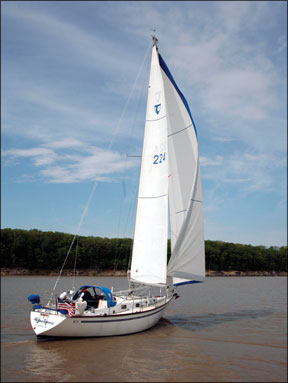Being stuck on the west coast of Florida, with two shoaling channels offering the easiest access out to the Gulf of Mexico, Ive suddenly become more interested in centerboard cruisers. Generally, Im not a huge proponent of adding moving parts to a cruising sailboat, but the attraction of being able to make reasonable progress to windward, feel secure in a blow, and explore skinny-water paradises that are off limits to conventional offshore designs is hard to resist.

So this week, I started a short list of 35- to 45-foot boats that looked interesting to me. Some Ive sailed on; some I havent. Practical Sailor has reviewed several of these boats. (Ive provided links to the reviews of boats we have looked at.) Id be interested in adding to this list and hearing thoughts from other owners of centerboard cruisers.
They are listed in no particular order.
1. Krogen 38. I grew up down the street from the Krogen family on Key Biscayne and had the chance to visit Jims design studio when I was just starting out as a reporter back in the 1980s. This is a pure cruising cutter that Krogen designed for himself. It has two bronze centerboards, one in front of the other, making it very easy to balance on long passages. Pros: This is a robust, three-cabin cruising boat with a loyal following. Cons: Cored hull and teak decks on boats of this age can be landmines. Are two centerboards double trouble?
2. Morgan 41. Ive sailed on a couple of these sloops and like the way they look and sail. The boats heritage gives it a loyal following (a good thing to look for in any used boat). Pros: Storied design, with a good deck layout and comfortable motion. Cons: Finish quality varies greatly as many were owner-completed. Factory interior is pretty basic.
3. Tartan 37. A classic Sparkman & Stephens design. Three different couples my wife, Theresa, and I cruised in company with in the Caribbean had Tartan 37s, and all of them were happy with the boat. Pros: A very popular dual-purpose classic with good bones. Cons: A bit pricey for the size and vintage, and not as spacious as contemporary 37-footers.

4. Ovni 43. In the Pacific and Southeast Asia, we sailed with two different couples cruising aboard these aluminum boats, made popular by circumnavigator, rally organizer, and author Jimmy Cornell. Pros: Tough aluminum construction, good track record. Cons: High price, and used boats are hard to find.
5. Block Island 40. Ive never sailed on this fabled yawl designed by Bill Tripp, but PS Technical Editor Ralph Naranjo often cites it as an example of rugged construction. Pros: Proven offshore design with a cult-like following. Cons: Many of the older Block Island 40s require expensive upgrades that will quickly eat through a cruising budget.
6. Bristol 35.5. This Ted Hood design marked Bristols push into the big-boat market under Bristols boss Clint Pearson. Pros: This is a solidly built and popular Bermuda veteran. Cons: Totally enclosed cable makes it difficult to service. Not as spacious as contemporary cruisers in this size.
7. Sabre 38 MkI or MkII. Ive sailed several Sabres, ranging from the older Roger Hewson designed 34s to the new-generation Jim Taylor boats, and have always been impressed with the way they handled. Pros: Sabres craftsmanship is generally above average for production boats. Stick-built interior is more amenable to owner conversions. Cons: Outside of the Northeast, Sabres do not carry as much value as some other brands.
I initially thought Id dig up 10 boats, but with Thanksgiving around the corner, the crush of work and family obligations, Im calling this project to a halt for now. Happy Thanksgiving! Id love to hear some other suggestions to help round out the list!



































Hood Gulfstar 40